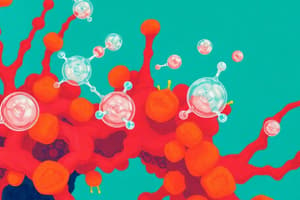Podcast
Questions and Answers
How does the amide group in sulfonamides affect their polarity?
How does the amide group in sulfonamides affect their polarity?
The amide group lowers the polarity of sulfonamides, making them less ionisable.
What role do enzymes play in the metabolism of sulfonamide prodrugs?
What role do enzymes play in the metabolism of sulfonamide prodrugs?
Enzymes, such as peptidases, metabolize sulfonamide prodrugs to generate primary amines.
Identify a key clinical application of sulfonamides.
Identify a key clinical application of sulfonamides.
Sulfonamides are commonly used to treat urinary tract infections.
What is the significance of R2 in sulfanilamide analogues?
What is the significance of R2 in sulfanilamide analogues?
How do sulfonamides differ in effectiveness compared to penicillins?
How do sulfonamides differ in effectiveness compared to penicillins?
What advantage do alkyl groups provide to sulfonamide prodrugs?
What advantage do alkyl groups provide to sulfonamide prodrugs?
What enzyme do sulphonamides competitively inhibit and why is this target significant?
What enzyme do sulphonamides competitively inhibit and why is this target significant?
Explain how sulphonamides mimic para-aminobenzoic acid (PABA) in their mechanism of action.
Explain how sulphonamides mimic para-aminobenzoic acid (PABA) in their mechanism of action.
Why are sulphonamides considered bacteriostatic agents rather than bactericidal?
Why are sulphonamides considered bacteriostatic agents rather than bactericidal?
Describe the metabolic process that sulphonamides undergo and its implications.
Describe the metabolic process that sulphonamides undergo and its implications.
Identify the main reason why sulphonamides may not be ideal for patients with weakened immune systems.
Identify the main reason why sulphonamides may not be ideal for patients with weakened immune systems.
What distinguishes the presence of dihydropteroate synthetase in bacterial cells from human cells?
What distinguishes the presence of dihydropteroate synthetase in bacterial cells from human cells?
Discuss the impact of resistant bacterial strains on the efficacy of sulphonamides.
Discuss the impact of resistant bacterial strains on the efficacy of sulphonamides.
Why might sulphonamides not be utilized as prodrugs for gut infections?
Why might sulphonamides not be utilized as prodrugs for gut infections?
What is the significance of the primary amino group in the structure of sulphonamides?
What is the significance of the primary amino group in the structure of sulphonamides?
How does Prontosil function as a prodrug in the treatment of infections?
How does Prontosil function as a prodrug in the treatment of infections?
What role does the aromatic ring play in the structure-activity relationships of sulphonamides?
What role does the aromatic ring play in the structure-activity relationships of sulphonamides?
Why must the sulphonamide nitrogen be primary or secondary for effective antibacterial activity?
Why must the sulphonamide nitrogen be primary or secondary for effective antibacterial activity?
Discuss the clinical application of sulfanilamide as a synthetic antibacterial agent.
Discuss the clinical application of sulfanilamide as a synthetic antibacterial agent.
What is the mechanism of action by which sulphonamides exert their antibacterial effect?
What is the mechanism of action by which sulphonamides exert their antibacterial effect?
Explain the concept of prodrugs in the context of sulphonamides and gut infections.
Explain the concept of prodrugs in the context of sulphonamides and gut infections.
How does para-substitution on the sulphonamide structure affect its activity?
How does para-substitution on the sulphonamide structure affect its activity?
Flashcards are hidden until you start studying
Study Notes
Mechanism of Action
- Dihydropteroate synthetase is a bacterial enzyme absent in human cells.
- Plays a vital role in the biosynthesis of tetrahydrofolate cofactor, crucial for pyrimidine and DNA biosynthesis.
- Essential for cell growth and division.
Sulphonamides
- Act as competitive enzyme inhibitors and are classified as bacteriostatic agents.
- Not recommended for immunocompromised patients due to reduced efficacy.
- Mimic substrate para-aminobenzoic acid (PABA) to bind at the active site, inhibiting its access.
- Inhibition is reversible, with resistance sometimes resulting from strains producing excess PABA.
Binding Interactions
- Binding involves hydrogen bonds, van der Waals interactions, and ionic bonds at the active site of the enzyme.
Metabolic Differences
- Dihydropteroate synthetase exists exclusively in bacterial cells.
- Transport protein for folic acid is only found in mammalian cells.
Sulphonamides - Drug Metabolism
- Metabolized primarily through N-acetylation, which increases hydrophobicity and decreases aqueous solubility.
- This metabolic change can cause toxic side effects due to the formation of insoluble metabolites.
Prodrugs of Sulphonamides
- Amide groups reduce polarity and prevent ionization, enhancing gut wall absorption.
- Alkyl groups confer increased hydrophobicity, facilitating metabolism by enzymes (e.g., peptidases) and leading to active primary amines.
- The ionized primary amine can form ionic interactions and acts as a strong hydrogen bond donor.
Sulphanilamide Analogues
- Structure involves variations of aromatic and heteroaromatic rings (R2).
- Structural differences affect plasma protein binding, blood levels, solubility, and pharmacokinetics; pharmacodynamics remain unchanged.
Applications of Sulphanilamides
- Historically used as the main antibacterial agents before the advent of penicillins in the 1930s.
- Current applications include treatment of urinary tract infections, eye lotions, gut infections, and mucous membrane infections.
Lead Compound
- Prontosil, a red dye, was identified as having antibacterial activity in vivo but was inactive in vitro.
- Metabolized into the active sulphonamide, establishing its role as a prodrug.
- Sulphanilamide became the first synthetic antibacterial agent effective against a variety of infections.
Structure-Activity Relationships
- The primary amino group (R1=H) is critical for activity.
- Amide groups can also be present (R1=acyl), leading to prodrug forms that are inactive until metabolized.
- The presence of an aromatic ring and para-substitution of the sulphonamide group is essential for activity, along with the nitrogen being primary or secondary in structure.
Studying That Suits You
Use AI to generate personalized quizzes and flashcards to suit your learning preferences.




